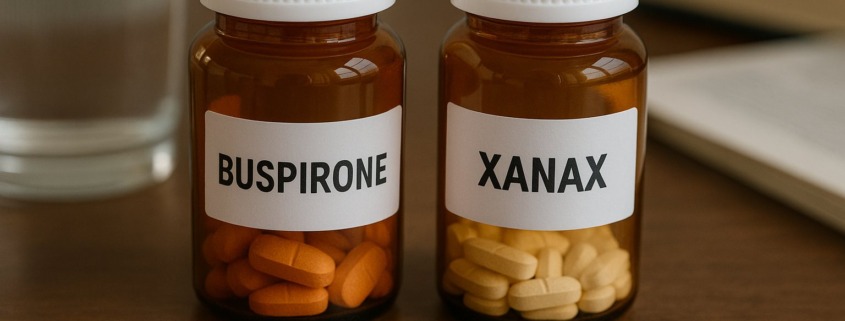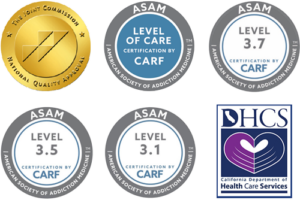Buspirone vs Xanax
Published on: November 6, 2025
Understanding Your Anti-Anxiety Medication Options
Anxiety disorders affect millions of Americans, disrupting daily life and making even routine activities feel overwhelming. When anxiety becomes unmanageable, medication may be an important component of comprehensive treatment. Two commonly prescribed anti-anxiety medications—buspirone and Xanax (alprazolam)—offer different approaches to managing anxiety symptoms, each with distinct benefits, risks, and applications.
For individuals struggling with anxiety or those concerned about medication dependence, understanding the fundamental differences between these two drugs is essential for making informed treatment decisions. While both medications effectively reduce anxiety, they work through entirely different mechanisms, carry different risk profiles, and serve different clinical purposes.
What Is Buspirone?
Buspirone, formerly marketed under the brand name BuSpar, belongs to a unique class of anti-anxiety medications called azapirones. Unlike many other anxiety treatments, buspirone is not a benzodiazepine, which gives it a fundamentally different safety profile regarding addiction and dependence.
How Buspirone Works
Buspirone primarily affects serotonin receptors in the brain, particularly the 5-HT1A subtype, while also having mild effects on dopamine receptors. This mechanism differs significantly from benzodiazepines, which target GABA receptors. By modulating serotonin activity, buspirone helps regulate mood and reduce anxiety symptoms gradually over time.
The medication does not produce immediate sedation or a noticeable “calming” sensation when first taken, which is why some patients initially question its effectiveness. Instead, buspirone works by slowly adjusting brain chemistry to reduce anxiety symptoms over several weeks.
Approved Uses for Buspirone
The FDA has approved buspirone specifically for the treatment of generalized anxiety disorder (GAD), a condition characterized by persistent, excessive worry about various aspects of daily life. Healthcare providers may also prescribe buspirone off-label as an adjunct treatment for depression, particularly when combined with antidepressants.
Unlike medications designed for acute anxiety relief, buspirone is intended for ongoing, long-term management of chronic anxiety symptoms.
Buspirone Dosage and Administration
Buspirone typically starts at a low dose of 7.5 mg taken twice daily, which can be gradually increased based on response and tolerability. The usual therapeutic dose ranges from 20-30 mg daily, divided into two or three doses, with a maximum daily dose of 60 mg.
The medication requires consistent daily use to maintain effectiveness—it cannot be taken “as needed” like some other anxiety medications. Missing doses can reduce its therapeutic benefits, making adherence an important factor in treatment success.
Timeline for Buspirone Effects
One of buspirone’s most significant characteristics is its delayed onset of action. Unlike fast-acting anxiety medications, buspirone typically requires 2-4 weeks of consistent use before patients notice significant improvement in anxiety symptoms. Full therapeutic benefits often take 4-6 weeks to develop.
This delayed timeline can be frustrating for individuals seeking immediate relief, but it reflects the medication’s mechanism of gradually rebalancing brain chemistry rather than providing acute symptom suppression.
What Is Xanax?
Xanax (alprazolam) is a benzodiazepine, one of the most widely prescribed classes of anti-anxiety medications. Benzodiazepines have been used for decades to treat various anxiety conditions, though their use has become more cautious in recent years due to concerns about dependence and misuse.
How Xanax Works
Xanax enhances the activity of gamma-aminobutyric acid (GABA), the brain’s primary inhibitory neurotransmitter. GABA slows down nervous system activity, producing a calming effect that reduces anxiety and promotes relaxation. By increasing GABA’s effectiveness, Xanax quickly dampens the overactive neural circuits that generate anxiety symptoms.
This rapid action on the central nervous system explains both Xanax’s effectiveness for acute anxiety and its potential for dependence—the brain quickly adapts to the enhanced GABA activity, sometimes leading to tolerance and withdrawal symptoms.
Approved Uses for Xanax
The FDA has approved Xanax for generalized anxiety disorder and panic disorder in adults. However, approval specifies short-term use only—generally no longer than 4 months for GAD and 10 weeks for panic disorder.
Healthcare providers may also prescribe Xanax off-label for other conditions, including acute anxiety episodes, anticipatory anxiety before medical procedures, and certain phobias, though these uses fall outside official FDA approval.
Xanax Dosage and Administration
Xanax is available in immediate-release tablets (ranging from 0.25 mg to 2 mg) and extended-release formulations. For generalized anxiety disorder, treatment typically begins with 0.25-0.5 mg taken three times daily, with adjustments based on response.
The immediate-release formulation provides quick relief but requires multiple daily doses, while extended-release versions offer longer duration with once-daily dosing.
Timeline for Xanax Effects
Unlike buspirone, Xanax works quickly. Most patients feel its anxiety-reducing effects within 30 minutes to one hour after taking a dose. This rapid onset makes Xanax particularly useful for acute anxiety episodes or panic attacks, where immediate symptom relief is needed.
However, the effects are relatively short-lived—immediate-release Xanax typically provides relief for 4-6 hours, necessitating multiple doses throughout the day for sustained anxiety management.
Buspirone vs. Xanax: Key Differences
While both medications treat anxiety, they differ substantially in nearly every important characteristic.
Mechanism of Action
Buspirone affects serotonin and dopamine systems, working gradually to rebalance brain chemistry over weeks. This approach reduces chronic anxiety without producing sedation or significantly altering consciousness.
Xanax enhances GABA activity, rapidly slowing down nervous system activity to provide quick anxiety relief. This produces noticeable calming effects but also affects alertness, coordination, and cognitive function.
Speed of Effect
Buspirone requires 2-6 weeks of consistent use before providing significant anxiety relief. There is no immediate sensation of reduced anxiety after taking a dose.
Xanax begins working within 30-60 minutes, providing rapid relief from anxiety symptoms. Patients typically notice an immediate calming effect.
Duration of Use
Buspirone is designed for long-term use and can be safely continued for months or years without significant concern for dependence. The medication maintains effectiveness without requiring dose increases over time.
Xanax is approved only for short-term use (weeks to months) due to risks of tolerance, dependence, and withdrawal. Long-term benzodiazepine use carries substantial risks and is generally discouraged.
Addiction and Dependence Risk
Buspirone carries minimal risk of physical dependence or addiction. It does not produce euphoria or a “high,” making it unappealing for misuse. Stopping buspirone, even abruptly, rarely causes significant withdrawal symptoms.
Xanax carries substantial risk for physical dependence and addiction, particularly with regular use. The Drug Enforcement Administration classifies it as a Schedule IV controlled substance. Tolerance develops quickly, often requiring higher doses for the same effect. Abrupt discontinuation can cause severe withdrawal symptoms, including rebound anxiety, insomnia, tremors, and in severe cases, seizures.
Side Effects Profile
Buspirone common side effects include dizziness, headache, nausea, nervousness, and lightheadedness. These effects are generally mild and tend to diminish with continued use. Buspirone does not cause significant sedation or cognitive impairment.
Xanax common side effects include drowsiness, fatigue, impaired coordination, memory problems, confusion, and slurred speech. These sedative effects can significantly impact daily functioning, particularly activities requiring alertness like driving or operating machinery.
Clinical Applications
Buspirone excels as a first-line treatment for generalized anxiety disorder, particularly when long-term management is needed. It’s ideal for patients who need to maintain full alertness and cognitive function, those with substance use history who need to avoid addictive medications, and individuals who can wait several weeks for symptom improvement.
Xanax is most appropriate for short-term management of severe anxiety, acute panic attacks requiring immediate relief, bridging therapy while waiting for long-term treatments to take effect, and specific situational anxiety (such as flight phobia or medical procedures).
Safety Considerations and Risks
Understanding the safety profile of each medication helps patients and providers make informed decisions about anxiety treatment.
Buspirone Safety Profile
Buspirone is generally well-tolerated with a favorable safety profile. It does not cause respiratory depression, carries no significant overdose risk when taken alone, and can be safely used in patients with substance use history. The medication does not impair coordination or cognitive function significantly, allowing patients to drive and work normally.
However, buspirone can interact with other medications, particularly MAO inhibitors, certain antidepressants, and medications metabolized through the CYP3A4 enzyme system. Patients should inform their healthcare provider of all medications and supplements they take.
Xanax Safety Profile and Black Box Warning
Xanax carries a black box warning—the FDA’s most serious safety alert—for several serious risks. The warning highlights risks of abuse, misuse, and addiction, particularly dangerous interactions with opioids that can cause respiratory depression and death, and potential for severe withdrawal symptoms requiring medical management.
Additional safety concerns include increased fall risk, particularly in older adults, memory impairment and cognitive effects, potential for overdose, especially when combined with alcohol or other depressants, and increased risk of motor vehicle accidents due to impaired reaction time and coordination.
Pregnancy and Breastfeeding
Buspirone is categorized as Pregnancy Category B, indicating animal studies show no fetal risk, though human studies are limited. It should be used during pregnancy only if clearly needed and prescribed by a healthcare provider who understands the potential risks and benefits.
Xanax is Pregnancy Category D, indicating positive evidence of fetal risk. Benzodiazepine use during pregnancy has been associated with birth defects, withdrawal symptoms in newborns, and developmental concerns. Xanax is generally avoided during pregnancy unless the benefits clearly outweigh the risks.
Both medications can pass into breast milk, and nursing mothers should discuss risks with their healthcare provider.
Alcohol and Drug Interactions
Combining anxiety medications with other substances requires careful consideration.
Alcohol Interactions
Buspirone and alcohol: While buspirone doesn’t have the same dangerous interaction as benzodiazepines, combining it with alcohol can increase side effects like dizziness and drowsiness. Alcohol may also reduce buspirone’s effectiveness in treating anxiety.
Xanax and alcohol: This combination is extremely dangerous and potentially fatal. Both substances depress the central nervous system, and their combined effects can cause severe sedation, respiratory depression, loss of consciousness, and death. This combination should always be avoided.
Drug Interactions
Buspirone interacts with MAO inhibitors (can cause dangerous blood pressure increases), SSRIs and SNRIs (may increase serotonin syndrome risk), CYP3A4 inhibitors like grapefruit juice (increase buspirone levels), and CYP3A4 inducers like St. John’s Wort (decrease buspirone effectiveness).
Xanax interacts with opioid pain medications (life-threatening respiratory depression), other CNS depressants including sleep medications (enhanced sedation), certain antifungal medications (increased Xanax levels), and HIV protease inhibitors (increased Xanax levels and toxicity risk).
Discontinuing Treatment: Withdrawal Considerations
How you stop taking these medications matters significantly.
Stopping Buspirone
Discontinuing buspirone is generally straightforward and can often be done without tapering, though some individuals may experience mild rebound anxiety or dizziness if stopped abruptly. Working with a healthcare provider to develop a discontinuation plan is still advisable, but withdrawal symptoms are typically minimal compared to benzodiazepines.
Stopping Xanax
Discontinuing Xanax requires careful medical supervision and a gradual tapering schedule. Abrupt cessation of benzodiazepines can trigger severe and potentially life-threatening withdrawal symptoms including rebound anxiety (often worse than original symptoms), insomnia and disturbed sleep, tremors and muscle aches, seizures (in severe cases), confusion and cognitive difficulties, and panic attacks.
A healthcare provider will develop a personalized tapering schedule, gradually reducing the dose over weeks or months to minimize withdrawal symptoms and ensure safety.
Which Medication Is Right for You?
Choosing between buspirone and Xanax depends on multiple factors related to your specific situation, anxiety type, and treatment goals.
Consider Buspirone If You:
- Need long-term anxiety management for generalized anxiety disorder
- Can wait 2-4 weeks for medication to take full effect
- Want to avoid sedation and maintain full alertness
- Have a history of substance use and need non-addictive options
- Need to drive or operate machinery regularly
- Prefer a medication with minimal withdrawal concerns
Consider Xanax If You:
- Experience acute panic attacks requiring immediate relief
- Need short-term anxiety management during a crisis period
- Require medication while waiting for long-term treatments to work
- Have severe anxiety that hasn’t responded to other treatments
- Are willing to accept strict medical supervision and dependence risks
- Understand and can manage the potential for withdrawal symptoms
Important Consultation Factors
Only a qualified healthcare provider can determine which medication is most appropriate for your specific situation. Factors they’ll consider include severity and type of anxiety symptoms, duration of treatment needed, medical history and current health conditions, history of substance use or addiction, other medications you’re currently taking, lifestyle factors and daily responsibilities, and previous response to anxiety medications.
Comprehensive Treatment: Beyond Medication
While medication can be an important component of anxiety treatment, the most effective approach typically combines pharmaceutical intervention with other evidence-based therapies.
Psychotherapy for Anxiety
Cognitive-behavioral therapy (CBT) has demonstrated exceptional effectiveness for anxiety disorders, teaching skills to identify and change anxious thought patterns, develop coping strategies for anxiety-producing situations, and gradually face feared situations in a controlled manner.
Other beneficial therapeutic approaches include exposure therapy for specific phobias and panic disorder, acceptance and commitment therapy (ACT) for managing anxiety, mindfulness-based stress reduction (MBSR), and dialectical behavior therapy (DBT) for emotional regulation.
Lifestyle Modifications
Research consistently shows that lifestyle factors significantly impact anxiety levels. Important modifications include regular physical exercise, which naturally reduces anxiety, adequate sleep (7-9 hours nightly), stress management techniques like meditation and deep breathing, limiting caffeine and stimulant intake, maintaining social connections and support systems, and establishing regular daily routines.
When Medication Dependence Becomes a Problem
For individuals who develop dependence on benzodiazepines like Xanax, specialized addiction treatment may be necessary. Warning signs of benzodiazepine dependence include taking higher doses than prescribed, using medication more frequently than directed, doctor shopping to obtain multiple prescriptions, experiencing anxiety about running out of medication, unsuccessful attempts to cut down or stop, and continued use despite negative consequences.
Specialized Treatment at Journey Hillside
At Journey Hillside in Tarzana, California, we understand that anxiety and substance dependence often coexist, creating complex treatment needs. Our comprehensive approach addresses both conditions simultaneously through evidence-based interventions.
Our Treatment Approach
Our anxiety and addiction treatment programs provide medically supervised detoxification for individuals dependent on benzodiazepines, psychiatric evaluation and medication management to find the right long-term anxiety treatment, individual therapy addressing underlying anxiety and trauma, group therapy providing peer support and skill development, family therapy rebuilding relationships affected by anxiety and substance use, and aftercare planning to maintain recovery and manage anxiety long-term.
Dual Diagnosis Treatment
Many individuals struggling with benzodiazepine dependence have underlying anxiety disorders that require ongoing treatment. Our dual diagnosis programs simultaneously address both conditions, ensuring clients receive appropriate anxiety management while safely withdrawing from dependence-forming medications.
Why Professional Support Matters
Attempting to discontinue benzodiazepines without professional support can be dangerous and often leads to relapse. Professional treatment provides medical monitoring to ensure safe withdrawal, evidence-based therapies addressing root causes of anxiety, medication management to find non-addictive alternatives, coping skills for managing anxiety without medication dependence, and ongoing support during the vulnerable recovery period.
Taking the Next Step
If you’re struggling with anxiety, concerned about medication dependence, or uncertain whether buspirone or Xanax might be appropriate for you, professional guidance is essential. Anxiety disorders are highly treatable, and numerous effective options exist beyond potentially addictive medications.
For those who have developed dependence on Xanax or other benzodiazepines, recovery is possible with proper support. The compassionate team at Journey Hillside has extensive experience helping individuals safely transition from benzodiazepine dependence to sustainable anxiety management strategies.
Don’t let anxiety or medication dependence control your life. Call Journey Hillside today at (877) 414-1024 to speak with an admissions counselor about our anxiety and substance abuse treatment programs. We accept most insurance plans and can often arrange admission within 24 hours. Your path to effective anxiety management and freedom from dependence starts with a single call.
References:
- National Institute of Mental Health. (2024). Anxiety Disorders. https://www.nimh.nih.gov/health/topics/anxiety-disorders
- National Center for Biotechnology Information. (2023). Buspirone. StatPearls. https://www.ncbi.nlm.nih.gov/books/NBK531477/
- National Center for Biotechnology Information. (2024). Alprazolam. StatPearls. https://www.ncbi.nlm.nih.gov/books/NBK538165/
- U.S. Food and Drug Administration. (2020). FDA requiring Boxed Warning updated to improve safe use of benzodiazepine drug class. https://www.fda.gov/drugs/drug-safety-and-availability/fda-requiring-boxed-warning-updated-improve-safe-use-benzodiazepine-drug-class
- Longo, L. P., & Johnson, B. (2000). Addiction: Part I. Benzodiazepines—Side Effects, Abuse Risk and Alternatives. American Family Physician, 61(7), 2121-2128. https://www.ncbi.nlm.nih.gov/pmc/articles/PMC6007645/
- Brett, J., & Murnion, B. (2015). Management of benzodiazepine misuse and dependence. Australian Prescriber, 38(5), 152-155. https://www.ncbi.nlm.nih.gov/pmc/articles/PMC4657308/
- American Psychological Association. (2017). Clinical Practice Guideline for the Treatment of PTSD. https://www.apa.org/ptsd-guideline/patients-and-families/cognitive-behavioral





